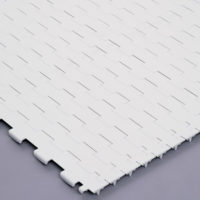Raising the Bar for Sanitation Standards

Superior sanitation is a critical component of any successful food processing operation. With food product recalls still fresh on everyone’s minds, demand for high-quality, safe food products has never been greater, and standards for hygienic practices have never been higher. Rather than responding as problems arise, taking proactive measures to ensure a hygienic operation is the most effective means of achieving excellent sanitation. The objective is to spot problems before they appear in food production.
The starting point in running a sanitary food processing operation is to have a food safety assessment system in place to identify potential hazards using the precepts of the Hazard Analysis and Critical Control Point (HACCP) system. When applied to conveyors, HACCP indicates that choosing the right belt for an application will result in more effective sanitation and elimination of contamination risk. Equipping a conveyor with belts and sprockets designed for effective cleaning greatly assists in raising hygienic standards.
When choosing a belt for a hygienic application, it is critical that food processors research their options, as not all modular plastic conveyor belts produce sanitary results that can be considered exemplary. Intralox’s conveyor belts are designed to facilitate improved cleaning efficiency. Used all over the world in various food processing applications, Intralox’s innovations raise the bar for cleanability in sanitation-critical applications.
Clearing debris is an essential foundation for any sanitation effort on food-related applications. When debris is allowed to build up on a carryway or on the interior components of a conveyor belt, problems such as production delays, shutdowns, or product recalls may arise. In addition, labor time and water usage can be wasted as a result. Intralox’s EZ Clean family of products, including belts that feature a SeamFree™ design, solves the issue of inefficient cleaning practices on food processing lines.
Molded from non-porous, non-absorbent plastic, each module of SeamFree™ belting can be assembled without bricklayed seams up to a width of 36 inches, making it the widest plastic module available on the market and minimizing debris trapping areas. The high beam strength of the SeamFree module enhances belt rigidity, while the patent-pending flume design on the underside of the belt effectively channels debris away from hinges and to the edge of the belt for easy cleaning. When used in sanitation-critical applications, SeamFree belting has been proven to deliver savings in water consumption and related energy costs, as well as in cleaning time and labor. With Intralox’s EZ Clean In Place system, processors can maximize the cleanability of the belts, as the system’s custom-engineered spray pattern of the high-impact nozzles thoroughly cleans the belt underside, sprockets and shafts.
When used in conjunction with Intralox’s patented Angled EZ Clean Sprockets, sanitation efficiency can be greatly increased. Traditional inline sprockets engage in the same area of the belt underside as they rotate, making certain portions of the belt inaccessible for cleaning. The design of the Angled EZ Clean Sprockets allows the sprocket teeth to engage in different portions of the belt underside as they rotate, allowing for cleaning access to 100% of the critical belt underside.
Open hinge belts have become quite popular on food processing lines due to their ability to allow full access to hinges for better cleaning; however, open hinge belts with a slotted design can leave space for debris to accumulate. Intralox’s Open Hinge belts, available in SeamFree design, feature cam-link hinges, which open wide around sprockets to maximize cleaning access to the hinge area, but close on the conveyor bed to prevent debris from clogging the belt.
The Next Level of Detection
While cleanability of a belt is certainly critical in hygienic applications, detectability of foreign objects in food products is paramount. All-plastic conveyor belt construction eliminates the risk of metal contamination from broken pieces of wire belting; however, additional measures must be taken to ensure that contamination does not occur.
To provide an appropriate level of detectability for sanitation-critical applications, Intralox offers a variety of detectable belt materials for food processors. Color of belt materials is the first level of detection offered. Intralox belts are manufactured in a variety of colors to facilitate easy visual detection of product contamination. To provide additional assurance, Intralox offers metal-detectable belts for light-duty applications, which are filled with a high-quality, rust-proof metal material that allows extremely small belt pieces to be detected. Finally, the ultimate belt material choice for detecting contamination is Intralox’s X-ray detectable acetal. Designed specifically to be detected by X-ray machines, this material exhibits a good balance of mechanical, thermal and chemical properties. The material reduces contamination risks for processors by allowing detection of pieces as small as 2 mm in size. (Note: Testing belt material in a production environment is the best method for determining detection sensitivity.)
As hygienic standards increase, it is important that food processors are continually offered the best products available for sanitary conveyance. Intralox’s highly trained team of food safety professionals stays on top of the latest regulations and continually tests products in both the lab and the field to discover the most effective cleaning practices. Their experience is available to customers through plant assessments, hands-on demonstrations and other resources to help deliver success to food processors around the globe.
www.intralox.com
Looking for a reprint of this article?
From high-res PDFs to custom plaques, order your copy today!






